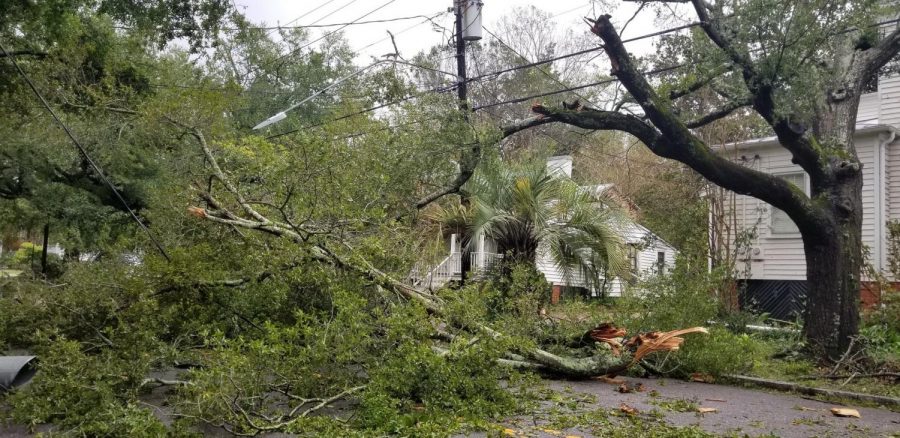AREA UPDATE: UNCW closed, flooding and road closures
Chantai Thomas/The Seahawk
In the area of downtown Wilmington near 4th and Dock Street, fallen trees and damaged power lines were brought as a result of high winds and rain brought by Hurricane Florence.
The following is an update and assessment of the effects of Hurricane Florence on UNC Wilmington, the surrounding area and eastern North Carolina.
Campus
In the wake of punishing winds and devastating flooding from Hurricane Florence, UNC Wilmington announced Monday that it would not reopen during the week of Sept. 17 through Sept. 21.
“State and local authorities continue to say people should not try to return to Wilmington from outside our area, nor should they be traveling on local roads if they are still in our area,” said the email from the Office of University Relations (OUR).
Hurricane Florence inundated New Hanover and surrounding counties over the weekend with torrential rains, which led to significant inland and coastal flooding. Due to high floodwaters and downed trees, Wilmington is effectively cut off from the rest of the state and has been described by multiple outlets as “a large island.”
UNCW has yet to respond to reports of damage on campus, including unconfirmed reports that Dobo Hall received extensive damage from the storm.
Damage to the university is being assessed by “a small but dedicated team of employees,” according to OUR, which may account for the lack of confirmation regarding damage on campus.
What few images that have emerged from campus show damage to most major roads due to fallen trees. Damaged was dealt to Boseman Field when Florence’s strong winds hurled the stadium’s bleachers into the playing area.
Flooding
While recently-downgraded Tropical Depression Florence barrels across the eastern United States, it has left tremendous flooding across southeastern North Carolina. Wilmington remains cut off from the rest of the world as of Sept. 17 and looks to continue that trend in the following days.
Heavy rains and river flooding have inundated almost all major highways and secondary roads leading to and from the city, including portions of Interstate 40 and U.S. Highways 17, 74-76, 117 and 421, according to the North Carolina Department of Transportation.
Floodwaters on some roads are not expected to recede until Tuesday or Wednesday as local rivers and streams crest to record or near-record heights.
The floodwaters are especially dire in locations such as Lumberton, Chinquapin and Burgaw, where the Lumber River and Cape Fear River are both cresting at record numbers.
According to the National Weather Service, these crests are topping records set by Hurricane Matthew just two years prior in October 2016.
If one absolutely has to travel to Wilmington, it is advised that they wait until at least Wednesday or Thursday – at the earliest.
Major closings
Interstate 40 is currently closed from exit 390 (Wallace) to the New Hanover County line at the Cape Fear River.
Interstate 95 is closed from U.S. Highway 64 in Rocky Mount south to N.C. Highway 82 just north of Fayetteville.
I-95 DETOUR: According to the NCDOT, all southbound traffic should take U.S. Highway 64 to Interstate 40 in Raleigh, and travel west to U.S. Highway 321 and divert their course south to Interstate 85 in Gastonia. Once in South Carolina, drivers should follow posted routes to return to Interstate 95.
U.S. Highway 74 is closed from Interstate 95 east into Columbus County and again in many places after its merger with U.S. Highway 76 through Columbus and Brunswick counties to Wilmington in New Hanover County.
Interstate 140 is closed from U.S. Highway 74-76 to U.S. Highway 17.
Expect this situation to quickly evolve over the next several days. Check back with The Seahawk for updates.








